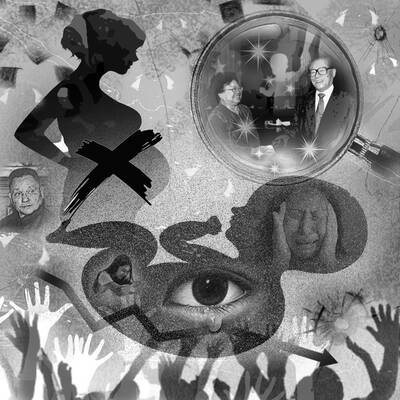Former British home secretary Robert Peel, credited as the father of modern policing, in 1829 established the Metropolitan Police, the world’s first professional police force.
In a force made up of ordinary citizens, police officers nicknamed “bobbies” were expected to adhere to the “Peelian principles,” often summarized as “policing by consent.” This meant that rather than using fear on the streets of London, “bobbies” had to secure and maintain the approval, respect and affection of the public, an ethos that is still followed. The Hong Kong Police Force of old, modeled on Britain’s police force, once adhered to these principles and was considered “Asia’s finest.”
Unfortunately, the latest violent clashes at the Hong Kong MTR’s Prince Edward Station on Saturday evening provide further evidence that Hong Kong police are increasingly using disproportionate violence to quell the unrelenting protest movement that has engulfed the former British colony.
Protesters on Saturday went ahead with a rally in defiance of the police.
A video uploaded to YouTube shows dozens of riot police sprinting down the platform at Prince Edward Station in pursuit of what appears to be a lone protester before tackling him to the ground. Officers then converge on a stationary train, pointing a tear gas gun through the open doors before storming carriages and, seemingly at random, spraying passengers with pepper spray and beating them with batons. A group of passengers is seen huddling in a corner, trying to shield themselves from the police, terrified and sobbing uncontrollably.
On Sunday, pro-democracy lawmakers held a news conference to condemn the use of extreme force.
Hong Kong Legislator Claudia Mo (毛孟靜) said: “Hong Kong people are now facing licensed terror attacks not just from the police force, but from the Hong Kong government.”
“What happened on an MTR train at Prince Edward Station was blatantly clear through press footage and photos, and police would still dare to deny ... that [they] were beating up ordinary citizens indiscriminately,” Mo said.
Civic Party Legislator Kwok Ka-ki (郭家麒) accused the police of “shameless behavior unbefitting of monsters.”
Such extreme levels of force being employed by police anywhere in Hong Kong, let alone within its safe and efficient metro rail system, would have seemed unthinkable just a few months ago.
Regrettably, Saturday evening’s carnage was not the first time Hong Kong police have used excessive force in the past few weeks. It follows multiple instances of officers firing rubber bullets, beanbag rounds and tear gas canisters at close range and at head height, targeting protesters.
In one particularly egregious example, a young woman was reportedly hit in the eye with a beanbag round at an anti-government protest outside Tsim Sha Tsui Police Station on Aug. 11. She is still receiving treatment to her shattered right eye, which could be irrecoverably damaged.
Hong Kong police increasingly look and act like a paramilitary outfit. Many officers wear olive-colored, army-style fatigues, instead of blue or black uniforms. The police regularly refuse to grant permission for rallies and last week conducted a dragnet operation, arresting many former student leaders of the 2014 “Umbrella movement” and other high-profile democracy advocates on trumped-up charges.
Following the events of the past few months, many Hong Kongers are understandably questioning whether Hong Kong Chief Executive Carrie Lam (林鄭月娥), who has repeatedly refused to condemn excessive force, has lost control not just of the Hong Kong Police Force, but effectively relinquished control of the territory’s governance to Beijing.
We are used to hearing that whenever something happens, it means Taiwan is about to fall to China. Chinese President Xi Jinping (習近平) cannot change the color of his socks without China experts claiming it means an invasion is imminent. So, it is no surprise that what happened in Venezuela over the weekend triggered the knee-jerk reaction of saying that Taiwan is next. That is not an opinion on whether US President Donald Trump was right to remove Venezuelan President Nicolas Maduro the way he did or if it is good for Venezuela and the world. There are other, more qualified
The immediate response in Taiwan to the extraction of Venezuelan President Nicolas Maduro by the US over the weekend was to say that it was an example of violence by a major power against a smaller nation and that, as such, it gave Chinese President Xi Jinping (習近平) carte blanche to invade Taiwan. That assessment is vastly oversimplistic and, on more sober reflection, likely incorrect. Generally speaking, there are three basic interpretations from commentators in Taiwan. The first is that the US is no longer interested in what is happening beyond its own backyard, and no longer preoccupied with regions in other
As technological change sweeps across the world, the focus of education has undergone an inevitable shift toward artificial intelligence (AI) and digital learning. However, the HundrED Global Collection 2026 report has a message that Taiwanese society and education policymakers would do well to reflect on. In the age of AI, the scarcest resource in education is not advanced computing power, but people; and the most urgent global educational crisis is not technological backwardness, but teacher well-being and retention. Covering 52 countries, the report from HundrED, a Finnish nonprofit that reviews and compiles innovative solutions in education from around the world, highlights a

Jan. 1 marks a decade since China repealed its one-child policy. Just 10 days before, Peng Peiyun (彭珮雲), who long oversaw the often-brutal enforcement of China’s family-planning rules, died at the age of 96, having never been held accountable for her actions. Obituaries praised Peng for being “reform-minded,” even though, in practice, she only perpetuated an utterly inhumane policy, whose consequences have barely begun to materialize. It was Vice Premier Chen Muhua (陳慕華) who first proposed the one-child policy in 1979, with the endorsement of China’s then-top leaders, Chen Yun (陳雲) and Deng Xiaoping (鄧小平), as a means of avoiding the